redis源码分析3---结构体---字典
Posted taoliu_alex
tags:
篇首语:本文由小常识网(cha138.com)小编为大家整理,主要介绍了redis源码分析3---结构体---字典相关的知识,希望对你有一定的参考价值。
redis源码分析3---结构体---字典
字典,简单来说就是一种用于保存键值对的抽象数据结构;
注意,字典中每个键都是独一无二的;在redis中,内部的redis的数据库就是使用字典作为底层实现的;
1 字典的实现
在redis中,字典是使用哈希表作为底层实现的,一个hash表里面可以有多个hash表节点,而每个hash表节点就保存了字典中的一个键值对;
hash表定义
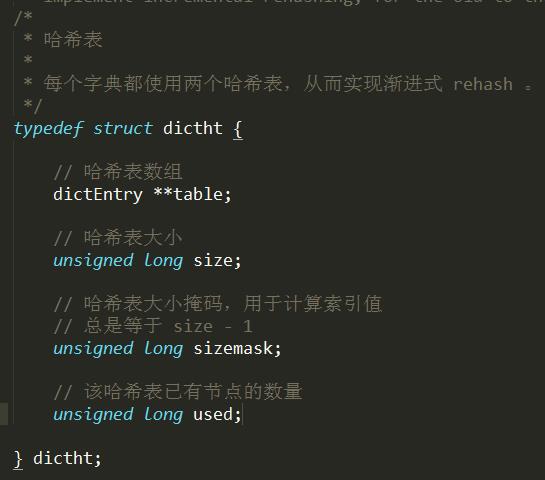
table属性是一个数组,数组中的每个元素都是一个指向dictEntry结构的指针,每个dictEntry结构保存着一个键值对;
一个空的hash表:
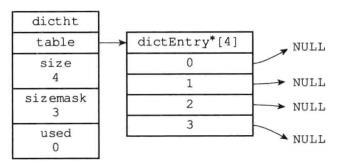
hash表节点
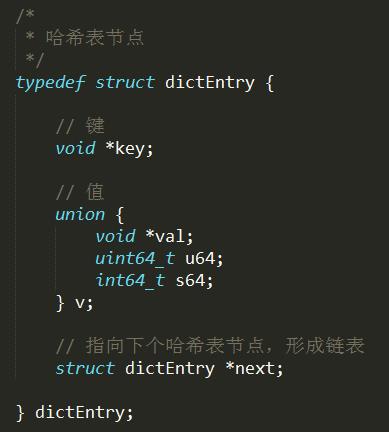
key保存键值对中的键,v为值,union表示三个钟选择一个,next是指向另一个hash表节点的指针,这个指针可以将多个hash值相同的键值对连接在一起,以此来解决冲突的问题;
比如

字典结构
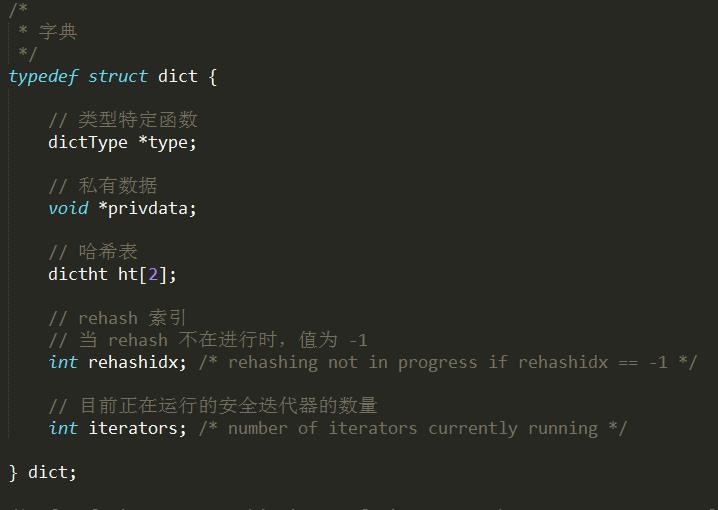



总的来说,没有rehash的字节结构图如下
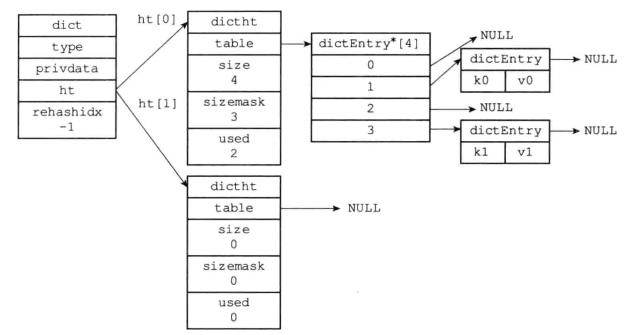
2 hash算法
当要将一个新的键值对添加到字典里面时,程序需要先根据键值对的键计算出hash值和索引值,然后再根据索引值,将包含新建支队的hash表节点放到哈市表数组的制定索引上面。
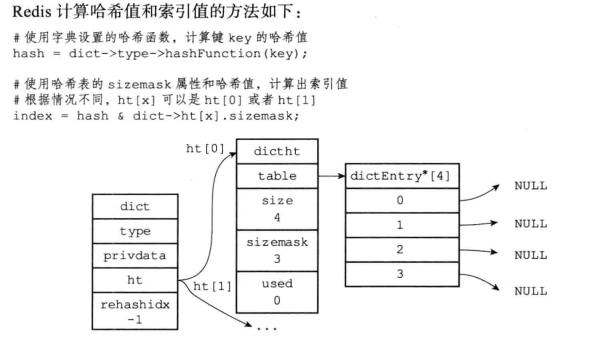



3 解决冲突
在hash表中不可避免的会出现冲突,当有两个或者两个以上的键被分配到了hash表数组的同一个索引上面时,就说发生了冲突;
在redis中使用链地址法来解决键冲突;就是我们在前面的结构中定义的next指针实现的;

4 rehash
在字典中,一个非常重要的特点就是使用了rehash的方法;
因为随着操作的不断执行,hash表保存的键值对会渐渐的增多或者减少,为了让hash表的敷在银子位置在一个合理的方位内,当hash表保存的键值对数量太多或者太少时,程序需要对hash的大小进行相应的扩展或者收缩。
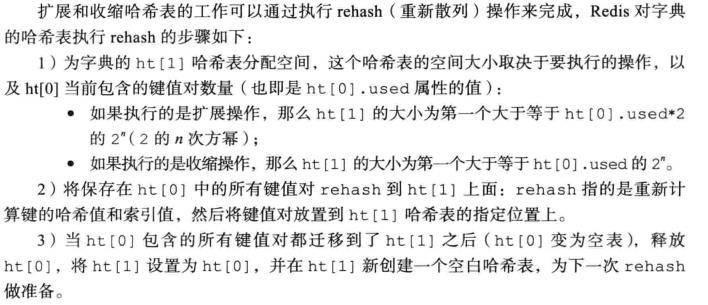

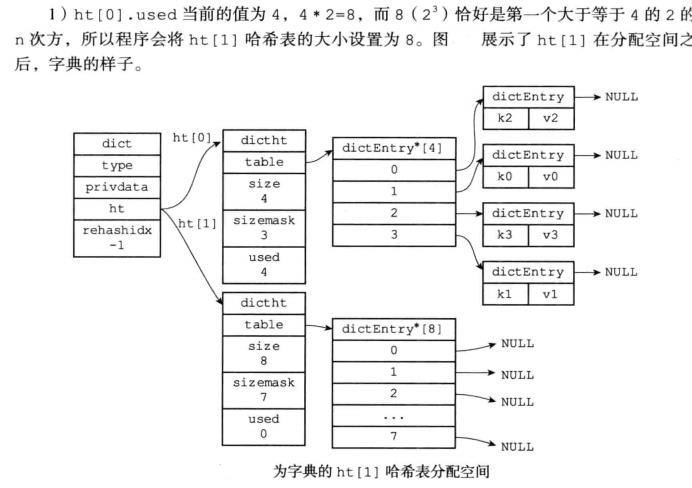
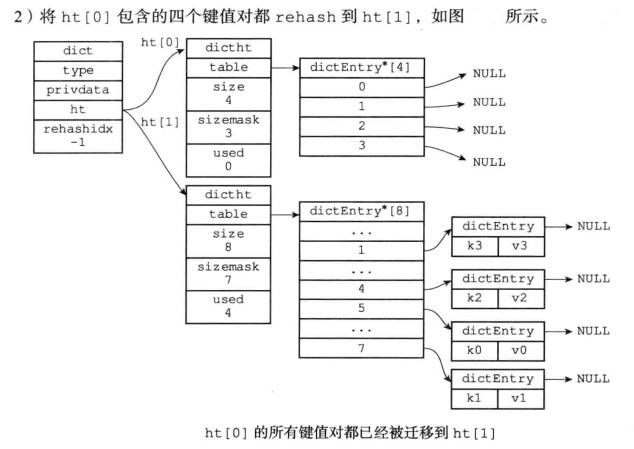

扩展或收缩hash表的方式

值得注意的是,在hash的扩展或者收缩的时候,并不是在某一时间内快速完成的,而是分多次,渐进的完成的。




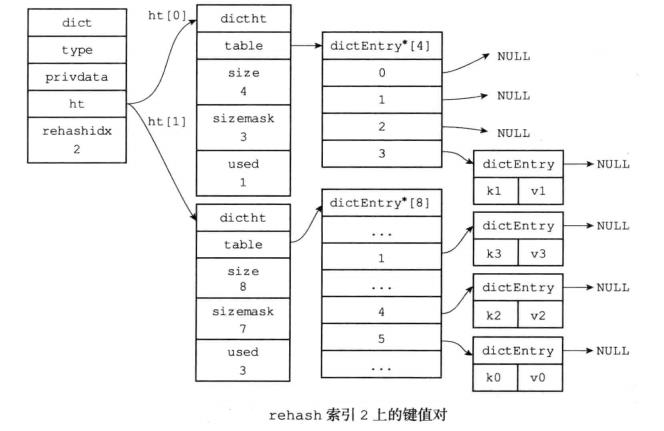
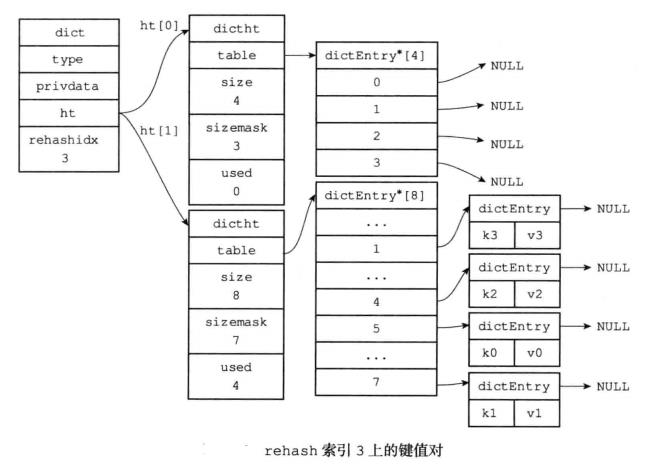
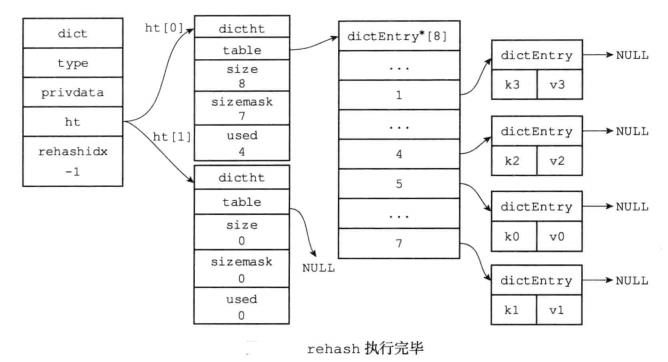
补充说明一下:在渐进式rehash中的时候,字典的删除,查找,更新等操作会在两个hash表上进行。
5 字典的API


6 源代码分析
6.1 字典迭代器
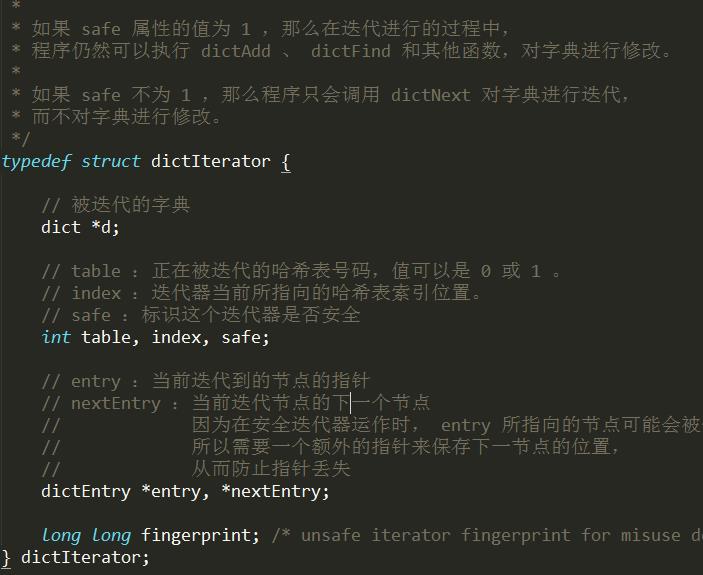
6.2
// 释放给定字典节点的值 #define dictFreeVal(d, entry) \\ if ((d)->type->valDestructor) \\ (d)->type->valDestructor((d)->privdata, (entry)->v.val) // 设置给定字典节点的值 #define dictSetVal(d, entry, _val_) do { \\ if ((d)->type->valDup) \\ entry->v.val = (d)->type->valDup((d)->privdata, _val_); \\ else \\ entry->v.val = (_val_); \\ } while(0) // 将一个有符号整数设为节点的值 #define dictSetSignedIntegerVal(entry, _val_) \\ do { entry->v.s64 = _val_; } while(0) // 将一个无符号整数设为节点的值 #define dictSetUnsignedIntegerVal(entry, _val_) \\ do { entry->v.u64 = _val_; } while(0) // 释放给定字典节点的键 #define dictFreeKey(d, entry) \\ if ((d)->type->keyDestructor) \\ (d)->type->keyDestructor((d)->privdata, (entry)->key) // 设置给定字典节点的键 #define dictSetKey(d, entry, _key_) do { \\ if ((d)->type->keyDup) \\ entry->key = (d)->type->keyDup((d)->privdata, _key_); \\ else \\ entry->key = (_key_); \\ } while(0) // 比对两个键 #define dictCompareKeys(d, key1, key2) \\ (((d)->type->keyCompare) ? \\ (d)->type->keyCompare((d)->privdata, key1, key2) : \\ (key1) == (key2)) // 计算给定键的哈希值 #define dictHashKey(d, key) (d)->type->hashFunction(key) // 返回获取给定节点的键 #define dictGetKey(he) ((he)->key) // 返回获取给定节点的值 #define dictGetVal(he) ((he)->v.val) // 返回获取给定节点的有符号整数值 #define dictGetSignedIntegerVal(he) ((he)->v.s64) // 返回给定节点的无符号整数值 #define dictGetUnsignedIntegerVal(he) ((he)->v.u64) // 返回给定字典的大小 #define dictSlots(d) ((d)->ht[0].size+(d)->ht[1].size) // 返回字典的已有节点数量 #define dictSize(d) ((d)->ht[0].used+(d)->ht[1].used) // 查看字典是否正在 rehash #define dictIsRehashing(ht) ((ht)->rehashidx != -1)
6.3 字典的添加和删除
/* Create a new hash table */ /* * 创建一个新的字典 * * T = O(1) */ dict *dictCreate(dictType *type, void *privDataPtr) { dict *d = zmalloc(sizeof(*d)); _dictInit(d,type,privDataPtr); return d; } /* Initialize the hash table */ /* * 初始化哈希表 * * T = O(1) */ int _dictInit(dict *d, dictType *type, void *privDataPtr) { // 初始化两个哈希表的各项属性值 // 但暂时还不分配内存给哈希表数组 _dictReset(&d->ht[0]); _dictReset(&d->ht[1]); // 设置类型特定函数 d->type = type; // 设置私有数据 d->privdata = privDataPtr; // 设置哈希表 rehash 状态 d->rehashidx = -1; // 设置字典的安全迭代器数量 d->iterators = 0; return DICT_OK; } /* Resize the table to the minimal size that contains all the elements, * but with the invariant of a USED/BUCKETS ratio near to <= 1 */ /* * 缩小给定字典 * 让它的已用节点数和字典大小之间的比率接近 1:1 * * 返回 DICT_ERR 表示字典已经在 rehash ,或者 dict_can_resize 为假。 * * 成功创建体积更小的 ht[1] ,可以开始 resize 时,返回 DICT_OK。 * * T = O(N) */ int dictResize(dict *d) { int minimal; // 不能在关闭 rehash 或者正在 rehash 的时候调用 if (!dict_can_resize || dictIsRehashing(d)) return DICT_ERR; // 计算让比率接近 1:1 所需要的最少节点数量 minimal = d->ht[0].used; if (minimal < DICT_HT_INITIAL_SIZE) minimal = DICT_HT_INITIAL_SIZE; // 调整字典的大小 // T = O(N) return dictExpand(d, minimal); } /* Expand or create the hash table */ /* * 创建一个新的哈希表,并根据字典的情况,选择以下其中一个动作来进行: * * 1) 如果字典的 0 号哈希表为空,那么将新哈希表设置为 0 号哈希表 * 2) 如果字典的 0 号哈希表非空,那么将新哈希表设置为 1 号哈希表, * 并打开字典的 rehash 标识,使得程序可以开始对字典进行 rehash * * size 参数不够大,或者 rehash 已经在进行时,返回 DICT_ERR 。 * * 成功创建 0 号哈希表,或者 1 号哈希表时,返回 DICT_OK 。 * * T = O(N) */ int dictExpand(dict *d, unsigned long size) { // 新哈希表 dictht n; /* the new hash table */ // 根据 size 参数,计算哈希表的大小 // T = O(1) unsigned long realsize = _dictNextPower(size); /* the size is invalid if it is smaller than the number of * elements already inside the hash table */ // 不能在字典正在 rehash 时进行 // size 的值也不能小于 0 号哈希表的当前已使用节点 if (dictIsRehashing(d) || d->ht[0].used > size) return DICT_ERR; /* Allocate the new hash table and initialize all pointers to NULL */ // 为哈希表分配空间,并将所有指针指向 NULL n.size = realsize; n.sizemask = realsize-1; // T = O(N) n.table = zcalloc(realsize*sizeof(dictEntry*)); n.used = 0; /* Is this the first initialization? If so it\'s not really a rehashing * we just set the first hash table so that it can accept keys. */ // 如果 0 号哈希表为空,那么这是一次初始化: // 程序将新哈希表赋给 0 号哈希表的指针,然后字典就可以开始处理键值对了。 if (d->ht[0].table == NULL) { d->ht[0] = n; return DICT_OK; } /* Prepare a second hash table for incremental rehashing */ // 如果 0 号哈希表非空,那么这是一次 rehash : // 程序将新哈希表设置为 1 号哈希表, // 并将字典的 rehash 标识打开,让程序可以开始对字典进行 rehash d->ht[1] = n; d->rehashidx = 0; return DICT_OK; /* 顺带一提,上面的代码可以重构成以下形式: if (d->ht[0].table == NULL) { // 初始化 d->ht[0] = n; } else { // rehash d->ht[1] = n; d->rehashidx = 0; } return DICT_OK; */ } /* Performs N steps of incremental rehashing. Returns 1 if there are still * keys to move from the old to the new hash table, otherwise 0 is returned. * * 执行 N 步渐进式 rehash 。 * * 返回 1 表示仍有键需要从 0 号哈希表移动到 1 号哈希表, * 返回 0 则表示所有键都已经迁移完毕。 * * Note that a rehashing step consists in moving a bucket (that may have more * than one key as we use chaining) from the old to the new hash table. * * 注意,每步 rehash 都是以一个哈希表索引(桶)作为单位的, * 一个桶里可能会有多个节点, * 被 rehash 的桶里的所有节点都会被移动到新哈希表。 * * T = O(N) */ int dictRehash(dict *d, int n) { // 只可以在 rehash 进行中时执行 if (!dictIsRehashing(d)) return 0; // 进行 N 步迁移 // T = O(N) while(n--) { dictEntry *de, *nextde; /* Check if we already rehashed the whole table... */ // 如果 0 号哈希表为空,那么表示 rehash 执行完毕 // T = O(1) if (d->ht[0].used == 0) { // 释放 0 号哈希表 zfree(d->ht[0].table); // 将原来的 1 号哈希表设置为新的 0 号哈希表 d->ht[0] = d->ht[1]; // 重置旧的 1 号哈希表 _dictReset(&d->ht[1]); // 关闭 rehash 标识 d->rehashidx = -1; // 返回 0 ,向调用者表示 rehash 已经完成 return 0; } /* Note that rehashidx can\'t overflow as we are sure there are more * elements because ht[0].used != 0 */ // 确保 rehashidx 没有越界 assert(d->ht[0].size > (unsigned)d->rehashidx); // 略过数组中为空的索引,找到下一个非空索引 while(d->ht[0].table[d->rehashidx] == NULL) d->rehashidx++; // 指向该索引的链表表头节点 de = d->ht[0].table[d->rehashidx]; /* Move all the keys in this bucket from the old to the new hash HT */ // 将链表中的所有节点迁移到新哈希表 // T = O(1) while(de) { unsigned int h; // 保存下个节点的指针 nextde = de->next; /* Get the index in the new hash table */ // 计算新哈希表的哈希值,以及节点插入的索引位置 h = dictHashKey(d, de->key) & d->ht[1].sizemask; // 插入节点到新哈希表 de->next = d->ht[1].table[h]; d->ht[1].table[h] = de; // 更新计数器 d->ht[0].used--; d->ht[1].used++; // 继续处理下个节点 de = nextde; } // 将刚迁移完的哈希表索引的指针设为空 d->ht[0].table[d->rehashidx] = NULL; // 更新 rehash 索引 d->rehashidx++; } return 1; } /* * 返回以毫秒为单位的 UNIX 时间戳 * * T = O(1) */ long long timeInMilliseconds(void) { struct timeval tv; gettimeofday(&tv,NULL); return (((long long)tv.tv_sec)*1000)+(tv.tv_usec/1000); } /* Rehash for an amount of time between ms milliseconds and ms+1 milliseconds */ /* * 在给定毫秒数内,以 100 步为单位,对字典进行 rehash 。 * * T = O(N) */ int dictRehashMilliseconds(dict *d, int ms) { // 记录开始时间 long long start = timeInMilliseconds(); int rehashes = 0; while(dictRehash(d,100)) { rehashes += 100; // 如果时间已过,跳出 if (timeInMilliseconds()-start > ms) break; } return rehashes; } /* This function performs just a step of rehashing, and only if there are * no safe iterators bound to our hash table. When we have iterators in the * middle of a rehashing we can\'t mess with the two hash tables otherwise * some element can be missed or duplicated. * * 在字典不存在安全迭代器的情况下,对字典进行单步 rehash 。 * * 字典有安全迭代器的情况下不能进行 rehash , * 因为两种不同的迭代和修改操作可能会弄乱字典。 * * This function is called by common lookup or update operations in the * dictionary so that the hash table automatically migrates from H1 to H2 * while it is actively used. * * 这个函数被多个通用的查找、更新操作调用, * 它可以让字典在被使用的同时进行 rehash 。 * * T = O(1) */ static void _dictRehashStep(dict *d) { if (d->iterators == 0) dictRehash(d,1); } /* Add an element to the target hash table */ /* * 尝试将给定键值对添加到字典中 * * 只有给定键 key 不存在于字典时,添加操作才会成功 * * 添加成功返回 DICT_OK ,失败返回 DICT_ERR * * 最坏 T = O(N) ,平滩 O(1) */ int dictAdd(dict *d, void *key, void *val) { // 尝试添加键到字典,并返回包含了这个键的新哈希节点 // T = O(N) dictEntry *entry = dictAddRaw(d,key); // 键已存在,添加失败 if (!entry) return DICT_ERR; // 键不存在,设置节点的值 // T = O(1) dictSetVal(d, entry, val); // 添加成功 return DICT_OK; } /* Low level add. This function adds the entry but instead of setting * a value returns the dictEntry structure to the user, that will make * sure to fill the value field as he wishes. * * This function is also directly exposed to user API to be called * mainly in order to store non-pointers inside the hash value, example: * * entry = dictAddRaw(dict,mykey); * if (entry != NULL) dictSetSignedIntegerVal(entry,1000); * * Return values: * * If key already exists NULL is returned. * If key was added, the hash entry is returned to be manipulated by the caller. */ /* * 尝试将键插入到字典中 * * 如果键已经在字典存在,那么返回 NULL * * 如果键不存在,那么程序创建新的哈希节点, * 将节点和键关联,并插入到字典,然后返回节点本身。 * * T = O(N) */ dictEntry *dictAddRaw(dict *d, void *key) { int index; dictEntry *entry; dictht *ht; // 如果条件允许的话,进行单步 rehash // T = O(1) if (dictIsRehashing(d)) _dictRehashStep(d); /* Get the index of the new element, or -1 if * the element already exists. */ // 计算键在哈希表中的索引值 // 如果值为 -1 ,那么表示键已经存在 // T = O(N) if ((index = _dictKeyIndex(d, key)) == -1) return NULL; // T = O(1) /* Allocate the memory and store the new entry */ // 如果字典正在 rehash ,那么将新键添加到 1 号哈希表 // 否则,将新键添加到 0 号哈希表 ht = dictIsRehashing(d) ? &d->ht[1] : &d->ht[0]; // 为新节点分配空间 entry = zmalloc(sizeof(*entry)); // 将新节点插入到链表表头 entry->next = ht->table[index]; ht->table[index] = entry; // 更新哈希表已使用节点数量 ht->used++; /* Set the hash entry fields. */ // 设置新节点的键 // T = O(1) dictSetKey(d, entry, key); return entry; } /* Add an element, discarding the old if the key already exists. * * 将给定的键值对添加到字典中,如果键已经存在,那么删除旧有的键值对。 * * Return 1 if the key was added from scratch, 0 if there was already an * element with such key and dictReplace() just performed a value update * operation. * * 如果键值对为全新添加,那么返回 1 。 * 如果键值对是通过对原有的键值对更新得来的,那么返回 0 。 * * T = O(N) */ int dictReplace(dict *d, void *key, void *val) { dictEntry *entry, auxentry; /* Try to add the element. If the key * does not exists dictAdd will suceed. */ // 尝试直接将键值对添加到字典 // 如果键 key 不存在的话,添加会成功 // T = O(N) if (dictAdd(d, key, val) == DICT_OK) return 1; /* It already exists, get the entry */ // 运行到这里,说明键 key 已经存在,那么找出包含这个 key 的节点 // T = O(1) entry = dictFind(d, key); /* Set the new value and free the old one. Note that it is important * to do that in this order, as the value may just be exactly the same * as the previous one. In this context, think to reference counting, * you want to increment (set), and then decrement (free), and not the * reverse. */ // 先保存原有的值的指针 auxentry = *entry; // 然后设置新的值 // T = O(1) dictSetVal(d, entry, val); // 然后释放旧值 // T = O(1) dictFreeVal(d, &auxentry); return 0; } /* dictReplaceRaw() is simply a version of dictAddRaw() that always * returns the hash entry of the specified key, even if the key already * exists and can\'t be added (in that case the entry of the already * existing key is returned.) * * See dictAddRaw() for more information. */ /* * dictAddRaw() 根据给定 key 释放存在,执行以下动作: * * 1) key 已经存在,返回包含该 key 的字典节点 * 2) key 不存在,那么将 key 添加到字典 * * 不论发生以上的哪一种情况, * dictAddRaw() 都总是返回包含给定 key 的字典节点。 * * T = O(N) */ dictEntry *dictReplaceRaw(dict *d, void *key) { // 使用 key 在字典中查找节点 // T = O(1) dictEntry *entry = dictFind(d,key); // 如果节点找到了直接返回节点,否则添加并返回一个新节点 // T = O(N) return entry ? entry : dictAddRaw(d,key); } /* Search and remove an element */ /* * 查找并删除包含给定键的节点 * * 参数 nofree 决定是否调用键和值的释放函数 * 0 表示调用,1 表示不调用 * * 找到并成功删除返回 DICT_OK ,没找到则返回 DICT_ERR * * T = O(1) */ static int dictGenericDelete(dict *d, const void *key, int nofree) { unsigned int h, idx; dictEntry *he, *prevHe; int table; // 字典(的哈希表)为空 if (d->ht[0].size == 0) return DICT_ERR; /* d->ht[0].table is NULL */ // 进行单步 rehash ,T = O(1) if (dictIsRehashing(d)) _dictRehashStep(d); // 计算哈希值 h = dictHashKey(d, key); // 遍历哈希表 // T = O(1) for (table = 0; table <= 1; table++) { // 计算索引值 idx = h & d->ht[table].sizemask; // 指向该索引上的链表 he = d->ht[table].table[idx]; prevHe = NULL; // 遍历链表上的所有节点 // T = O(1) while(he) { if (dictCompareKeys(d, key, he->key)) { // 超找目标节点 /* Unlink the element from the list */ // 从链表中删除 if (prevHe) prevHe->next = he->next; else d->ht[table].table[idx] = he->next; // 释放调用键和值的释放函数? if (!nofree) { dictFreeKey(d, he); dictFreeVal(d, he); } // 释放节点本身 zfree(he); // 更新已使用节点数量 d->ht[table].used--; // 返回已找到信号 return DICT_OK; } prevHe = he; he = he->next; } // 如果执行到这里,说明在 0 号哈希表中找不到给定键 // 那么根据字典是否正在进行 rehash ,决定要不要查找 1 号哈希表 if (!dictIsRehashing(d)) break; } // 没找到 return DICT_ERR; /* not found */ } /* * 从字典中删除包含给定键的节点 * * 并且调用键值的释放函数来删除键值 * * 找到并成功删除返回 DICT_OK ,没找到则返回 DICT_ERR * T = O(1) */ int dictDelete(dict *ht, const void *key) { return dictGenericDelete(ht,key,0); } /* * 从字典中删除包含给定键的节点 * * 但不调用键值的释放函数来删除键值 * * 找到并成功删除返回 DICT_OK ,没找到则返回 DICT_ERR * T = O(1) */ int dictDeleteNoFree(dict *ht, const void *key) { return dictGenericDelete(ht,key,1); } /* Destroy an entire dictionary */ /* * 删除哈希表上的所有节点,并重置哈希表的各项属性 * * T = O(N) */ int _dictClear(dict *d, dictht *ht, void(callback)(void *)) { unsigned long i; /* Free all the elements */ // 遍历整个哈希表 // T = O(N) for (i = 0; i < ht->size && ht->used > 0; i++) { dictEntry *he, *nextHe; if (callback && (i & 65535) == 0) callback(d->privdata); // 跳过空索引 if ((he = ht->table[i]) == NULL) continue; // 遍历整个链表 // T = O(1) while(he) { nextHe = he->next; // 删除键 dictFreeKey(d, he); // 删除值 dictFreeVal(d, he); // 释放节点 zfree(he); // 更新已使用节点计数 ht->used--; // 处理下个节点 he = nextHe; } } /* Free the table and the allocated cache structure */ // 释放哈希表结构 zfree(ht->table); /* Re-initialize the table */ // 重置哈希表属性 _dictReset(ht); return DICT_OK; /* never fails */ } /* Clear & Release the hash table */ /* * 删除并释放整个字典 * * T = O(N) */ void dictRelease(dict *d) { // 删除并清空两个哈希表 _dictClear(d,&d->ht[0],NULL); _dictClear(d,&d->ht[1],NULL); // 释放节点结构 zfree(d); }
6.4 字典查找和访问
/* * 返回字典中包含键 key 的节点 * * 找到返回节点,找不到返回 NULL * * T = O(1) */ dictEntry *dictFind(dict *d, const void *key) { dictEntry *he; unsigned int h, idx, table; // 字典(的哈希表)为空 if (d->ht[0].size == 0) return NULL; /* We don\'t have a table at all */ // 如果条件允许的话,进行单步 rehash if (dictIsRehashing(d)) _dictRehashStep(d); // 计算键的哈希值 h = dictHashKey(d, key); // 在字典的哈希表中查找这个键 // T = O(1) for (table = 0; table <= 1; table++) { //以上是关于redis源码分析3---结构体---字典的主要内容,如果未能解决你的问题,请参考以下文章